铷原子钟
原子钟的原理应用有哪些

原子钟的原理应用有哪些原子钟的原理原子钟是利用原子内部的电子转跃来测量时间的高精度时钟。
它基于原子的稳定性和精确的振荡频率来实现时间的准确测量。
常见的原子钟主要是以原子内部的电子转跃为基础的。
原子的稳定性原子钟中使用的原子通常是铯(Cesium)或铷(Rubidium),因为这两种元素的原子非常稳定。
原子钟中通常使用铯-133的同位素或铷-87的同位素。
电子转跃原子钟的工作原理基于原子内部的电子从低能级跃迁到高能级的过程。
电子转跃是原子内部的能量变化,对应着原子获得或失去能量的过程。
这种转跃是具有确定的能级差的,因此可以用时间来描述。
原子内部振荡频率的测量原子钟利用原子内部振荡频率的稳定性来测量时间。
原子在特定能级转跃过程中会发射或吸收特定频率的辐射。
原子钟通过测量辐射频率的稳定性来确定精确的时间。
原子钟的应用原子钟已经广泛应用于各个领域,具有重要的意义。
下面列举了几个原子钟的主要应用:•精确时间测量:原子钟可以提供非常高精度的时间测量。
它被广泛用于科学研究、航天航空、导航系统等领域,确保时间的准确性。
•全球定位系统(GPS):原子钟作为GPS系统的核心组件之一,用于测量卫星和地面定位站之间的微小时间差。
通过计算这些时间差,可以准确确定接收机的位置。
•时频传输:原子钟的高精度时间信号可以用于时频传输。
它被广泛应用于电信、金融、能源等领域,确保数据传输的准确性。
•科学研究:原子钟在科学研究中扮演着重要角色。
比如,在物理学研究中,原子钟被用来验证相对论、研究引力波等重要课题。
•防御和安全:原子钟在防御和安全领域有重要应用。
它被用于导弹发射系统、核电站控制、网络安全等领域,确保系统的稳定和安全。
•天体测量:原子钟可以提供精确的时间信号,用于测量地球和天体之间的微小差异。
它对于天体物理学研究和星际导航有着重要的作用。
•原子钟的进一步发展:随着科学技术的不断发展,原子钟也在不断进化。
目前,一些实验室已经实现了更高精度的原子钟,其应用前景更加广阔。
长期稳定度2.6×10 ^(-16) 的工程化高可靠铷原子喷泉钟
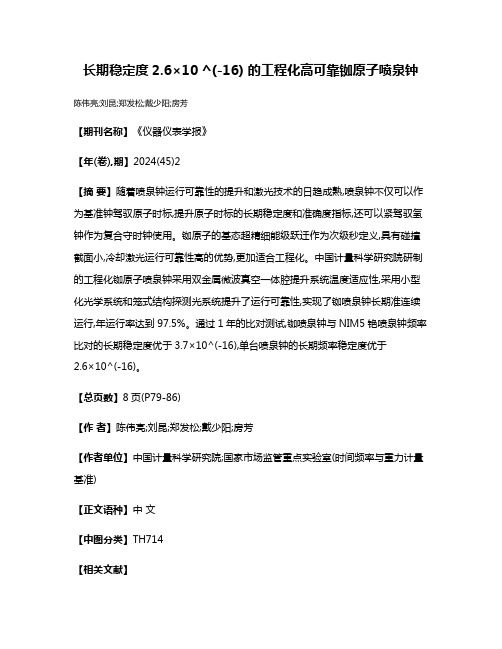
长期稳定度2.6×10 ^(-16) 的工程化高可靠铷原子喷泉钟陈伟亮;刘昆;郑发松;戴少阳;房芳
【期刊名称】《仪器仪表学报》
【年(卷),期】2024(45)2
【摘要】随着喷泉钟运行可靠性的提升和激光技术的日趋成熟,喷泉钟不仅可以作为基准钟驾驭原子时标,提升原子时标的长期稳定度和准确度指标,还可以紧驾驭氢钟作为复合守时钟使用。
铷原子的基态超精细能级跃迁作为次级秒定义,具有碰撞截面小,冷却激光运行可靠性高的优势,更加适合工程化。
中国计量科学研究院研制的工程化铷原子喷泉钟采用双金属微波真空一体腔提升系统温度适应性,采用小型化光学系统和笼式结构探测光系统提升了运行可靠性,实现了铷喷泉钟长期准连续运行,年运行率达到97.5%。
通过1年的比对测试,铷喷泉钟与NIM5铯喷泉钟频率比对的长期稳定度优于3.7×10^(-16),单台喷泉钟的长期频率稳定度优于
2.6×10^(-16)。
【总页数】8页(P79-86)
【作者】陈伟亮;刘昆;郑发松;戴少阳;房芳
【作者单位】中国计量科学研究院;国家市场监管重点实验室(时间频率与重力计量基准)
【正文语种】中文
【中图分类】TH714
【相关文献】
1.阶跃倍频器温度敏感性对铷原子钟频率稳定度的影响
2.激光参量对CPT铷原子钟稳定度影响的数值分析
3.泛华恒兴高准确度卫星驯服铷原子钟同步时钟卡PS-330
4.泛华恒兴推出高准确度卫星驯服铷原子钟同步时钟卡
5.一种铷原子钟频率稳定度估计方法研究
因版权原因,仅展示原文概要,查看原文内容请购买。
铷的元素符号

铷的元素符号介绍铷(Rb)是一种化学元素,属于碱金属。
它的元素符号是Rb,原子序数是37。
铷在自然界中以稀有元素的形式存在,主要由钾含量较高的矿石中分离提取得到。
铷具有一些特殊的物理和化学性质,使其在科学研究和工业应用中具有重要的地位。
特性铷是一种银白色的金属,具有低熔点和低沸点。
它的密度较大,可在常温下被切割和锻造。
铷的熔点仅为39摄氏度,使其成为所有金属中熔点最低的一种。
铷在常温下可以很容易地被氧气和水蒸气氧化。
铷也是一种相对有活性的金属,能与很多元素进行反应。
用途铷在工业、科研和医学领域有广泛的应用。
以下是一些主要的用途和应用领域:1. 原子钟铷具有非常稳定的原子核结构,因此可以用于构造精确的原子钟。
原子钟是一种计时装置,利用铷原子内部的特殊性质来测量时间。
原子钟在航空、通信和导航等领域中起到重要的作用。
2. 核磁共振成像(MRI)核磁共振成像是一种医学影像技术,常用于检查人体内部结构和疾病诊断。
铷的同位素铷-87具有磁性,可以被用于核磁共振成像中的标记物质。
通过与人体组织中的水分子相互作用,可以得到高分辨率的影像。
3. 光谱分析铷广泛应用于光谱学领域,特别是原子吸收光谱分析。
通过将铷原子置于光束中,可以根据不同波长的吸收率来测量样品中的铷含量。
这种方法被用于分析和检测环境中的化学物质,例如水中的污染物质。
4. 电池铷在一些高性能电池中被用作正极材料。
铷电池具有高能量密度和长寿命,适用于各种应用,如便携式电子设备、电动车和储能系统。
5. 配位化学铷在配位化学中具有重要作用。
配位化学是研究金属离子与配体之间相互作用的领域。
铷可以与一系列不同的配体形成配合物,这些配合物在催化、药物和材料科学等方面有着广泛的应用。
发现历史铷是由德国化学家恩斯特·卡尔·克劳斯于1861年通过萃取矿石中的铷盐分离而得到的。
克劳斯将这种新发现的元素命名为铷,取自拉丁语“rubidius”。
铷的化学性质受到了科学家们的广泛关注,并在不同领域的研究中得到了应用。
世界上最小的铷原子钟
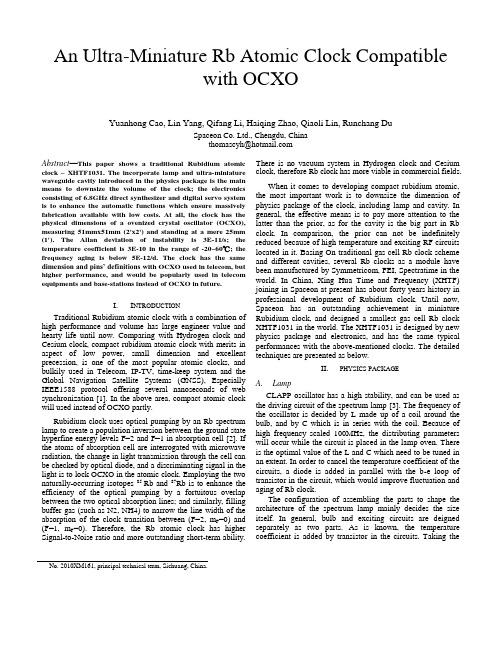
An Ultra-Miniature Rb Atomic Clock Compatiblewith OCXOYuanhong Cao, Lin Yang, Qifang Li, Haiqing Zhao, Qiaoli Lin, Runchang DuSpaceon Co. Ltd., Chengdu, Chinathomascyh@Abstract—This paper shows a traditional Rubidium atomic clock –XHTF1031. The incorporate lamp and ultra-miniature waveguide cavity introduced in the physics package is the main means to downsize the volume of the clock; the electronics consisting of 6.8GHz direct synthesizer and digital servo system is to enhance the automatic functions which ensure massively fabrication available with low costs. At all, the clock has the physical dimensions of a ovenized crystal oscillator (OCXO), measuring 51mmx51mm (2'x2') and standing at a mere 25mm (1'). The Allan deviation of instability is 3E-11/s; the temperature coefficient is 3E-10 in the range of -20~60℃; the frequency aging is below 5E-12/d. The clock has the same dimension and pins’ definitions with OCXO used in telecom, but higher performance, and would be popularly used in telecom equipments and base-stations instead of OCXO in future.I.I NTR ODUC TIONTraditional Rubidium atomic clock with a combination of high performance and volume has large engineer value and hearty life until now. Comparing with Hydrogen clock and Cesium clock, compact rubidium atomic clock with merits in aspect of low power, small dimension and excellent precession, is one of the most popular atomic clocks, and bulkily used in Telecom, IP-TV, time-keep system and the Global Navigation Satellite Systems (GNSS), Especially IEEE1588 protocol offering several nanoseconds of web synchronization [1]. In the above area, compact atomic clock will used instead of OCXO partly.Rubidium clock uses optical pumping by an Rb spectrum lamp to create a population inversion between the ground state hyperfine energy levels F=2 and F=1 in absorption cell [2]. If the atoms of absorption cell are interrogated with microwave radiation, the change in light transmission through the cell can be checked by optical diode, and a discriminating signal in the light is to lock OCXO in the atomic clock. Employing the two naturally-occurring isotopes 85 Rb and 87Rb is to enhance the efficiency of the optical pumping by a fortuitous overlap between the two optical absorption lines; and similarly, filling buffer gas (such as N2, NH4) to narrow the line width of the absorption of the clock transition between (F=2, m F=0) and (F=1, m F=0). Therefore, the Rb atomic clock has higher Signal-to-Noise ratio and more outstanding short-term ability. There is no vacuum system in Hydrogen clock and Cesium clock, therefore Rb clock has more viable in commercial fields.When it comes to developing compact rubidium atomic, the most important work is to downsize the dimension of physics package of the clock, including lamp and cavity. In general, the effective means is to pay more attention to the latter than the prior, as for the cavity is the big part in Rb clock. In comparison, the prior can not be indefinitely reduced because of high temperature and exciting RF circuits located in it. Basing On traditional gas cell Rb clock scheme and different cavities, several Rb clocks as a module have been manufactured by Symmetricom, FEI, Spectratime in the world. In China, Xing Hua Time and Frequency (XHTF) joining in Spaceon at present has about forty years history in professional development of Rubidium clock. Until now, Spaceon has an outstanding achievement in miniature Rubidium clock, and designed a smallest gas cell Rb clock XHTF1031 in the world. The XHTF1031 is designed by new physics package and electronics, and has the same typical performances with the above-mentioned clocks. The detailed techniques are presented as below.II.PHYSICS PACKAGEA. LampCLAPP oscillator has a high stability, and can be used as the driving circuit of the spectrum lamp [3]. The frequency of the oscillator is decided by L made up of a coil around the bulb, and by C which is in series with the coil. Because of high frequency scaled 100MHz, the distributing parameters will occur while the circuit is placed in the lamp oven. There is the optimal value of the L and C which need to be tuned in an extent. In order to cancel the temperature coefficient of the circuits, a diode is added in parallel with the b-e loop of transistor in the circuit, which would improve fluctuation and aging of Rb clock.The configuration of assembling the parts to shape the architecture of the spectrum lamp mainly decides the size itself. In general, bulb and exciting circuits are deigned separately as two parts. As is known, the temperature coefficient is added by transistor in the circuits. Taking theNo. 2010XM161, principal technical term, Sichuang, C hina.transistor into the case of lamp can be resolved. The spectrum lamp is called incorporate lamp. In the architecture, the bulb of lamp is held into solenoid and together inserts into a bold which is designed by Teflon which ensure the light density stable. All of these are fixed into a case which is designed by aluminum. The PCB is laid into the case simultaneously. In this way, the electromagnetic radicalization can be shielded effectively. Therefore, the power dissipation can be used to heat up the lamp, and the power of the lamp which is capable of reducing at an extent. In a word, the bottleneck in the aspect of the coefficient, the size and the power dissipation has been resolved in the incorporate lamp. The finalappearance of the lamp is shown in Fig. 1.Figure 1. The lamp removed from the clock XHTF1031.In the process of fabricating lamp, the bulbs are aged with high RF power and high temperature firstly. Secondly, the lamp will be supplied with higher voltage than it being in normal work. All the steps can ensure to fabricate lamp in bulk.B. cavityIn Rb atomic clock, cavity is a container where absorption cell is located in. Generally, the cavity made of metal, such as copper or aluminum, is resonant with the microwave of atomic transitive frequency from synthesizer which is to interrogate atoms in the absorption cell in order to result in discrimination signal. At thi s rate, the volume of the resonant cavity is the biggest hamper while developing miniature Rb clock. To reduce the size of cavity in Rubidium atomic clock, there are several types of cavity as below. The first is cylinder cavity of TE111 model, sometimes filled by Al 2O 3 ceramic [4]. Obviously, this cavity has too small Q quality to bring on poor short-term frequency instability while developing Rb clock by it. The second is magnetron cavity whose mode is similar to TE011, and has high Q quality. The cavity has been used in Hydrogen clock in advantage. But the complex architecture and difficulty in production by machine hamper its expanding to compact Rb clock.Telecom technology brings digital synthesizer to microwave frequency band, and several synthesizers beyond 7G occur nowadays. The synthesizer has the ability to output the enough power level of 6.8GHz to interrogate atom. So, the cavity has no necessity to be resonant with atomic frequency. Waveguide port is the avenue for microwave transmitting in a model. One port of the waveguide is enclosed as an emission source, and other port i s enclosed excluding a hole laid in the center of bottom as the diaphragm the lamp light goes through. Simultaneously, absorption cell insets into the space in the cavity. In this way, one cavity is shaped in the Rb clock. While designing the cavity, the parameters including diameter and length must be calculated. Due to the boundary abnormity from absorption cell and the hole, the simulation in magnetism is necessary and effective auxiliary tool tocalculate the parameters. The simulating is as in Fig. 2.Figure 2. The Cavity of theRb atomic clock XHTF1031.In Fig. 2, magnetic excitation is from a loop coupling the 6.8GHz microwave. In order to make excitation higher than electricity, there is a special hemicycle soldered with the coupling loop. A bolt made specially is to screw in and out to compensate the boundary abnormity in the cavity after inserting absorption cell. By the design, the tolerance of absorption cell size is bigger than the previous, and the cavity is more available to fabricate in bulk. There is no ceramic in side of the cavity; therefore the lower weight and higher performance in vibration and shock are implemented. In fact, the power level range of -20 to 0 dBm from frequency multiplier is ok to the cavity with screwing the bolt. In addition, the waveguide cavity is made of permalloy metal so as to reduce frequency shift resulted from magnetism.III. ELEC TRONICSElectronics in Rb clock consi sts of frequency multiplier which is to multiply 10MHz from OCXO or TCXO to 6.8GHz, and servo which is to synchronously check and output an error to lock VCXO.A. Frequency MultiplierTraditional frequency multiplier is designed with step recovery diode (SRD), while SRD has the special property whose capacitance has different quality on the tradition whilevoltage shifts from positive to negative. 6.8GHz microwave to excite atom is from the high order harmonic wave by SRD. In this way, the resonance cavity must be used as the selective loop to enhance the 6.8GHz microwave, and Rb atoms in the absorption cell laid in the resonance cavity will output theenough strength of discrimination signal by transmission of light intensity from lamp to lock VCXO. Owning to the configuration of frequency multiplier in Fig. 3, the above-mentioned cavity can be used in Rb atomic clock.Figure 3. The frequency mitiplier scheme block.In Fig. 3, the 10MHz from OCXO compares with the similar frequency feeding back from VCO in phase detector (PD), and the error voltage of the phase is filtered by Low Filter (LF). Finally, the 6.8GHz is locked in phase with 10MHz and modulated in frequency by 70Hz.B. Digital Servo SystemThis part is embedded in a Micro-programmed Control Unit (MCU). The detailed configuration is as below in Fig. 4.Figure 4. The digial servo system block.∙MCU is the center controller of the electronics in the Rb clock. The first function is to initialize external devices, including synthesizer, DA C20; the second is to sample the light intensity and temperature data and to process digital data to export an error to lock VCXO.∙C field is set by 12 bit DAC which can adjust the accuracy of 10MHz frequency standard signal with high resolution. Therefore, the Rb atomic clock can be disciplined by GNSS via tuning thi s DAC‟s trans iting data, so the long term stability will up to the level of satellite atomic clock.∙DAC20 consists of two 12 bit DAC and is an equivalent 20 bit DAC, which is to lock the VCXO in normal work and to make the VCXO to be in holdover status in abnormal work.∙Light sampler is to gather intensity of the lamp light which contains work status of the lamp and atomic discrimination signal. The first one could assist tocheck the lamp‟s off -on statue to shift the voltage from low to high, and the second is to lock VCXO. ∙Synthesizer as a frequency multiplier makes the 10MHz from VCXO to 6.834GHz directly and modulates the microwave with a low frequency 70Hz. The synthesizer is made up of a digital phase comparator, digital divider (Div.) and VCO. ∙The cavity-temp. controller and lamp-temp. controller are to control the cavity temperature and lamp temperature respectively according to destination value of temperature automatically.C. Monitor-control softwareThe monitor-control software is installed in the PC which communicates with Rb atomic clock with RS232 protocol. Otherwise, the clock‟s work status including lamp and cavity can be monitored real-timely. Furthermore, the software can also set the parameters including synthesizer‟s offset and divider coefficient. With the help of the software, the Rb clock can be massively produced at a low cost.D. Archetechure designThe digital electronics and novel physics package are introduced, and the ultra-miniature Rb atomic clock can be shaped in a low size scale. Because OCXO with 51mmx51mm dimension is popularly used, as is necessary to design the similar Rb clock. Therefore the XHTF1031 has completed on this idea. The clock without case is shown in the. Fig.5. It is clear the synthesizer is enclosed in a metal shield, and the 6.8GHz transmits from the synthesizer to cavity by a microwave line with mini SMB connector.Figure 5. Spaceon Rb atomic clock XHTF1031 with the cover removed.∙The two PCBs are overlapped and fixed by 4 sockets. The frequency multiplier is enclosed in a case and directly soldered on the small PCB which is aligned with the cavity and the lamp.∙The case of Rb atomic clock is made of permalloy metal and is to reduce frequency shift resulted from magnetism again. Therefore the magnetic sensitivity will be reduced at large and finally to achieve the 2E-11/G. finally, the dimension is 51mm×51mm×25mm which is compatible with the ordinary OCXO. Especially, the baseplate of the clock has 4 screw hole and can be held safely, which makes the clock…s frequency specifications tolerable on the condition of shock and vibration.IV. TES TAfter making the key-technique design, five prototypes of the clock have been fabricated. Firstly, we have tested the five clocks comprehensively. The data and figures of testing are as below.A. short-term frequency instabilityShort-term frequency instability is relative with noise from synthesizer and physics package and the strength of atomic discrimination. In Fig.6, the short-term frequency instability ofthe clock XHTF1031 is given.(a)(b)Figure 6. XHTF1031 short-term frequency instability. (a) The typical frequency accu racy of the clock. (b) The typical frequency Allan deviation ofthe clock.In Fig.6, the short-term frequency instability is showed. The frequency data are sampled per 1 second in two day, therefore the quality of frequency point is enough to calculate the Allan deviation. From the diagram, the short-term frequency instability is about 2.6E-11/s, 9E-12/10s, 2.8E-12/100s, which is satisfied with root tao in Allan deviation, and is laid in the middle level of compact Rb clock.Obviously, the data is better than ordinary OCXO‟s, especially in the term of 10s and the time with big scale.B. Temperature coefficientTemperature coefficient is most difficulty in gas cell Rb clock while Doppler shift from hot atoms in absorption cell is appended in resonant frequency [5]. In addition, integrating filer technique in compact Rb clock is popularly used in order to downsize the clock‟s volume and brings on bigger coefficient than the scheme of splitting filtering technique. In XHTF1031, the digital electronics is to compensate coefficient by the feeding-back error from the temperature sensor mounted the clock case. In thi s way, the perfect property of frequency vs. temperature is achieved finally in Fig.7 as below.Figure 7. The clock XHTF1031coefficent in the range of -20 to 60 ℃.The present temperature coefficient in the range of -20 to 60℃ is within 3E-10. Next step, the range of work temperature will be expanded to fit defense and avionics environment.C. AgingOwning to the bulb and absorption cell are made of a special glass which ingredients is researched by Spaceon, theaging of XHTF 1031 has the outstanding performance.Figure 8. The clock XHT F1031‟s Long-term aging test diagram.In Fig.8, the typical data i s below 5E-12/d, and better with two or more order of magnitude than ordinary OCXO‟s.V.CONCLUSIONThe ultra-miniature Rb atomic clock XHTF1031 basing on traditional gas cell Rb clock scheme is completed now. Furthermore, owning to introduced novel physics package and the digital electronics, the cost, power dissipation and dimension are reduced at large extent. Finally, the shape of the clock is 51mm x 51mm x 25mm (2' x 2' x 1') in the first version of the clock, which is better standing long-term frequency instability than OCXO, but compatible with it. In addition, the clock has better technique maturation than CPT clock occurring several years ago. Consequently, the clock will take on an important application position in future, and will be widely used in aspect of Global Navigation Satellite Systems (GNSS), IEEE1588 web, IP TV, Timing-keep system as frequency standard instead of OCXO with higher frequency performance two or more order of magnitude.A CKNOWLEDGMENTWe will extremely thank Clive Green and Dr. Cos mo in Quartzlock England for their encouragement and valuable talk while developing the atomic Rb clock. Clive Green tries his best to spread Rb clock for Spaceon in the world also. In addition, some work for designing the Rb clock is done by Junqi Xiang, Xingwen Zhao, Yongjun Liu, Haitao Lin, Miao Liu, Xiaohua Pu, Xuejin Huang.R EFERENCES[1]Mills D L. Internet Time Synchronization: the Network Time Protocol.IEEE Trans. Communications, 1991, 39(10): 1482.[2]Audoin C., Guinot B.: The Measurement of Time, Frequency andAtomic Clock, C ambridge, University Press 2001, pp. 211-215.[3]Jeff D. Crockett, Fullerton, Calif Lamp Oscillator For AtomicFrequency Standards. United States Patent 5,489,891.[4]Y. Koyama, et al., “ An Ultra-miniature Rubidium Frequency Standardwith two-cell scheme,”Proc. 49th Annual Symposium on Frequency Control, pp.33-38, 1995.[5]R. H. Dicke, the effect pf collisions upon the doppler width of spectrallines physical review volume 89, nu mber 2 january 15, 1953.。
原子钟的几种常见类型
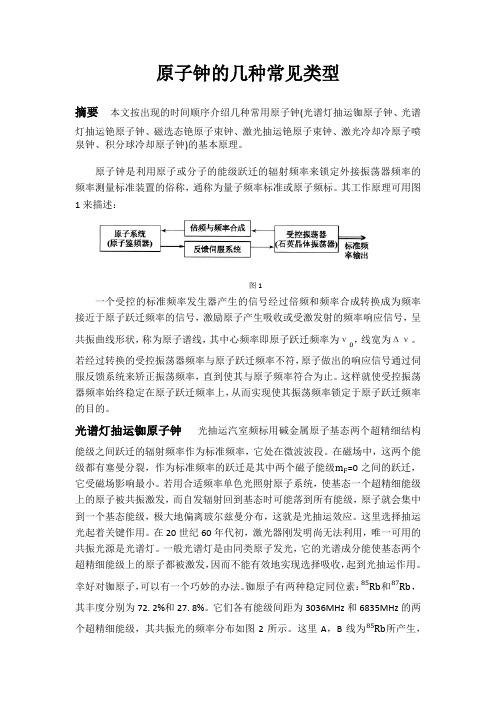
光谱灯发出的共振光经透镜聚焦后,通过置于谐振腔内的汽室被吸收,并在光电检测器上得到一定电平的光电信号。这相当于光抽运下原子在两个基态超精细能级上建立稳态分布时的信号,当谐振腔内电磁场频率与超精细跃迁相符时,原子在两个超精细能级之间发生跃迁,打破了原有的原子在能级上的平衡分布,又会发生新的光吸收,产生跃迁的光检测信号,即原子钟信号。
冷原子喷泉钟的基本想法如图7所示,搭建一个竖立的真空装置,真空中充
有工作介质(铷或铯)的饱和蒸汽,利用激光俘获原子并将其冷却,将原子上抛。原子在上抛和下落的过程中只受到重力作用,它两次穿过微波腔,与时间上的分离振荡场作用,产生钟跃迁,然后探测不同能级的原子。最后获得与Ramsey钟跃迁相应的荧光信号。这样极大减小了传统结构中两个振荡场不同所造成的相位频飘而且两次与微波振荡场作用时的速度等值反向,消除了一阶多普勒频移。[2]图7
积分球冷却原子钟积分球冷却原子钟的基本思想是把原子钟的所有相互作用(原子冷却、原子制备、微波探测和检测)都在同一地方发生,应用时序将各个阶段的作用分开。从而该钟可以减小到几升的体积。
积分球冷却原子钟的物理部分是由激光焊接的钛材做成,真空室由2L/s的离子泵维持在9* mPa。外面罩两层磁屏蔽。
为了满足冷却过程的需要,球形紫铜腔须光学抛光到λ/14的精度以便储存激光和产生各向同性的光场以供捕获和冷却原子用。同时,这个微波腔调谐在9。192GHz 模式,用于激励“钟”跃迁。微波腔内有一Cs原子储存泡,保持真空度在 乇。含泡腔的Q=3000。
图1
一个受控的标准频率发生器产生的信号经过倍频和频率合成转换成为频率接近于原子跃迁频率的信号,激励原子产生吸收或受激发射的频率响应信号,呈共振曲线形状,称为原子谱线,其中心频率即原子跃迁频率为 ,线宽为Δν。若经过转换的受控振荡器频率与原子跃迁频率不符,原子做出的响应信号通过伺服反馈系统来矫正振荡频率,直到使其与原子频率符合为止。这样就使受控振荡器频率始终稳定在原子跃迁频率上,从而实现使其振荡频率锁定于原子跃迁频率的目的。
铷钟

主要技术指标
频率稳定度 月频率漂移率
频率重现性 频率准确度
频率稳定度是频率偏差的起伏程度,实际上是一种可以用随机过程(平稳的或不平稳的)来研究和处理的问 题。频率稳定度在时域上的数学表征是阿伦标准偏差。
原子频标连续工作时,频率随时间单方向慢变化程度,用最小二乘法估计。通过GPS锁定,可改变铷原子钟 的漂移。铷原子钟的月漂移为:1×10-11~4×10-11。
铷频率标准不需要真空系统、致偏磁铁和原子束,因而体积小、质量小、预热时间短、价格便宜,但准确度 差、频率漂移比较大,仅能用作二级标准。铷频率标准可通过GPS进行快速驯服和外秒同步,克服铷振荡器本身 的漂移,可被看作是一个基本的同步时钟单元。通过设计和工艺的改进,产品的可靠性和批量生产也得到保证, 现已具备产业化的条件。可以预计,这种带外秒驯服的高性能小型化铷钟将应用于无人值守等苛刻环境,将大大 拓展铷钟的应用领域。
●漂移率
频率漂移率是铷原子频标的重要指标之一,通常认为光频移是导致整机频率漂移的主要因素,一般在零光强 频移泡温点,光强频移贡献约为1×10-12/1%,灯光强日漂移一般可达千分之一至万分之几,铷原子频率标准的 月漂移率应在4×10-11-5×10-12范围内。
●价格
选购铷原子钟需要考虑产品的价格范围,铷原子钟的价格取决于许多因素,包括稳定度、漂移率、准确度等。 一般情况下,相同指标的铷原子钟,国产比进口产品价格便宜。
特点
钟具有短期稳定性高,体积小巧,便于携带,价格合适的特点,非常适合于在各个领域使用,但由于铷原子 的原子特性的原因,铷钟并不具有铯钟和氢钟那样优秀的长期稳定度,因而需要校准。为了提高铷钟的长期稳定 度,可以通过使用GPS系统来对铷钟进行控制和校准。
GPS系统通过测量时间差来实现定位测量,为了达到较高的定位精度,GPS系统内部时间测量精度极高。通过 使用GPS系统来对铷钟进行校正,可以很好的提高铷钟的长期稳定度,降低铷钟输出信号的飘移。
原子钟的几种常见类型
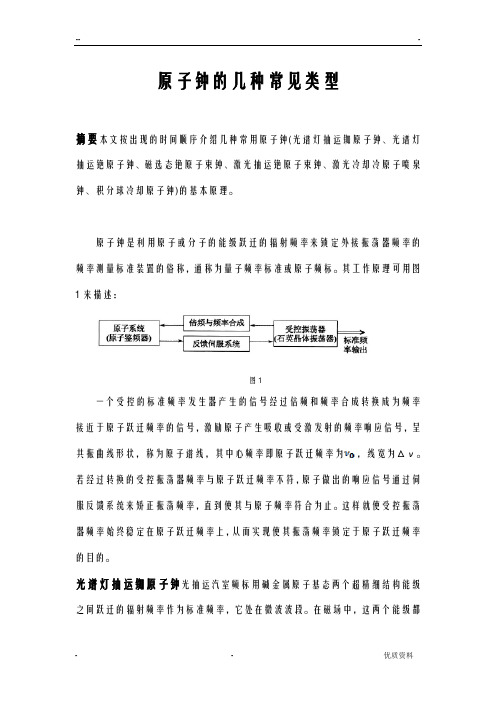
原子钟的几种常见类型摘要本文按出现的时间顺序介绍几种常用原子钟(光谱灯抽运铷原子钟、光谱灯抽运铯原子钟、磁选态铯原子束钟、激光抽运铯原子束钟、激光冷却冷原子喷泉钟、积分球冷却原子钟)的基本原理。
原子钟是利用原子或分子的能级跃迁的辐射频率来锁定外接振荡器频率的频率测量标准装置的俗称,通称为量子频率标准或原子频标。
其工作原理可用图1来描述:图1一个受控的标准频率发生器产生的信号经过倍频和频率合成转换成为频率接近于原子跃迁频率的信号,激励原子产生吸收或受激发射的频率响应信号,呈共振曲线形状,称为原子谱线,其中心频率即原子跃迁频率为,线宽为Δν。
若经过转换的受控振荡器频率与原子跃迁频率不符,原子做出的响应信号通过伺服反馈系统来矫正振荡频率,直到使其与原子频率符合为止。
这样就使受控振荡器频率始终稳定在原子跃迁频率上,从而实现使其振荡频率锁定于原子跃迁频率的目的。
光谱灯抽运铷原子钟光抽运汽室频标用碱金属原子基态两个超精细结构能级之间跃迁的辐射频率作为标准频率,它处在微波波段。
在磁场中,这两个能级都有塞曼分裂,作为标准频率的跃迁是其中两个磁子能级=0之间的跃迁,它受磁场影响最小。
若用合适频率单色光照射原子系统,使基态一个超精细能级上的原子被共振激发,而自发辐射回到基态时可能落到所有能级,原子就会集中到一个基态能级,极大地偏离玻尔兹曼分布,这就是光抽运效应。
这里选择抽运光起着关键作用。
在20世纪60年代初,激光器刚发明尚无法利用,唯一可用的共振光源是光谱灯。
一般光谱灯是由同类原子发光,它的光谱成分能使基态两个超精细能级上的原子都被激发,因而不能有效地实现选择吸收,起到光抽运作用。
幸好对铷原子,可以有一个巧妙的办法。
铷原子有两种稳定同位素:和,其丰度分别为72. 2%和27. 8%。
它们各有能级间距为3036MHz和6835MHz的两个超精细能级,其共振光的频率分布如图2所示。
这里A,B线为所产生,a,b线属于原子。
脉冲激光抽运铷原子钟理论与实验研究
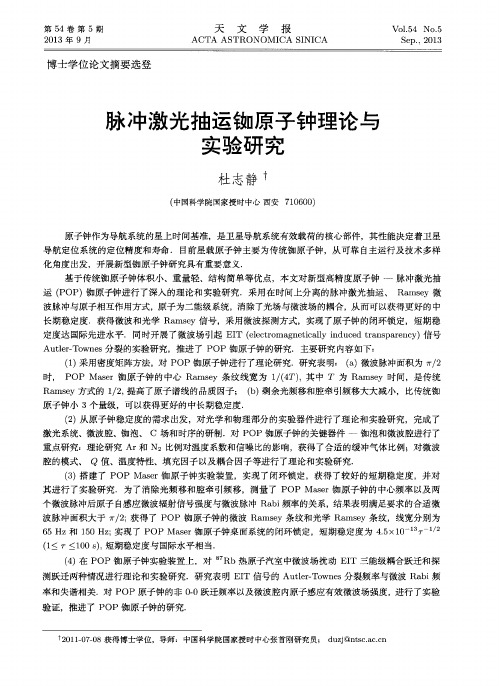
t 2 0 1 1 — 0 7 - 0 8获 得 博 士 学 位 , 导师 : 中国 科 学 院 国 家 授 时 中 心张 首 刚 研 究 员 ; d u z j  ̄n t s c . a c . c n
D U Z h i - j i n g
( N a t i o n a l T i m e S e r v i c e C e n t e r , C h i n e s e A c a d e m y o f S c i e n c e s , X i ’ a n 7 1 0 6 0 0 )
第 5 4 卷 第 5期
2 0 1 3 年 9月
天 文 学 报
ACTA AS TRON 0M I CA S I NI CA
Vo 1 . 54 N O. 5
S e p . , 2 0 1 3
博士 学位 论 文摘要 选登
脉 冲激光抽运铷 原子钟理论与 实验 研 究
杜 志静 十
腔的模式、 Q 值、温度特性、填 充因子 以及耦合 因子等进行 了理论和 实验研 究.
( 3 ) 搭 建了 POP Ma s e r铷原子钟实验装置,实现了闭环锁定,获得 了较好的短期稳定度,并 对 其进行 了实验研 究.为了消除光频移和腔牵 引频 移,测量 了 P OP Ma s e r铷 原子 钟的中心频率以及 两 个微波脉 冲后原子 自感应微波辐射信号强度与微波脉冲 Ra b i 频率的关 系, 结果表 明满足要求的合适 微
原子钟小 3个量级 ,可以获得更好 的中长期 稳定度 . ( 2 )从原子钟稳定度 的需求 出发 ,对光学和物理部分 的实验器 件进 行了理论和实验研究 ,完成了 激光系统、微 波腔 、铷泡、 C 场和 时序 的研制.对 P OP铷原子钟的关键器件 一 铷泡和微波腔进行了 重点研究:理论研 究 Ar 和 N 比例对温度系数和信 噪比的影响,获得 了合适的缓冲气体 比例;对微波
铷 工业指标

铷工业指标简介铷(Rubidium)是一种化学元素,属于碱金属。
它的原子序数为37,化学符号为Rb。
铷具有低熔点、低沸点和高反应性等特点,在工业生产中具有广泛的应用。
本文将详细介绍铷在工业中的指标及其相关内容。
1. 铷的物理性质•原子量:85.4678 g/mol•密度:1.532 g/cm³•熔点:39.31°C•沸点:688°C•摩尔体积:55.76 cm³/mol•半径:248 pm2. 铷的化学性质铷是一种高度活泼的金属元素。
它与氧、水和大多数非金属元素都能发生剧烈反应。
2.1 反应性铷能够与氧气反应生成氧化铷(Rb2O)。
在与水接触时,铷会迅速与水反应产生氢气和氢氧化铷(RbOH)。
此外,铷还能与酸类发生反应。
2.2 合金制备由于铷具有良好的合金制备性能,它常被用于制备各种合金。
例如,铷银合金具有较低的熔点和良好的电导率,可用于制作电极材料。
3. 铷在工业中的应用3.1 光电器件铷在光电器件中有着广泛的应用。
由于铷具有高度敏感的光学特性,它被广泛用于激光技术、光纤通信和光谱分析等领域。
铷原子钟是一种利用铷原子的特性来测量时间的高精度时钟。
3.2 医疗领域由于铷对生物体无毒且容易被人体吸收,它在医疗领域也有一定的应用。
例如,铷-82可以作为一种放射性示踪剂,用于检测心肌灌注。
3.3 燃料电池铷在燃料电池中被广泛应用。
燃料电池是一种将化学能直接转化为电能的装置,而铷则可以作为催化剂促进反应速率,提高燃料电池效率。
4. 铷工业指标4.1 生产量根据国际能源署的数据,全球铷的年产量约为500吨。
主要生产国家有中国、俄罗斯和加拿大等。
4.2 市场价格铷是一种稀有金属,市场价格相对较高。
根据市场供求关系和其他因素的影响,铷的价格会有所波动。
4.3 质量标准铷在工业中需要符合一定的质量标准。
例如,在光电器件领域,铷需要具备一定纯度和稳定性才能保证器件的性能。
结论铷作为一种重要的工业元素,在光电器件、医疗领域和燃料电池等领域都有着广泛应用。
基于铷原子钟的高精度守时技术
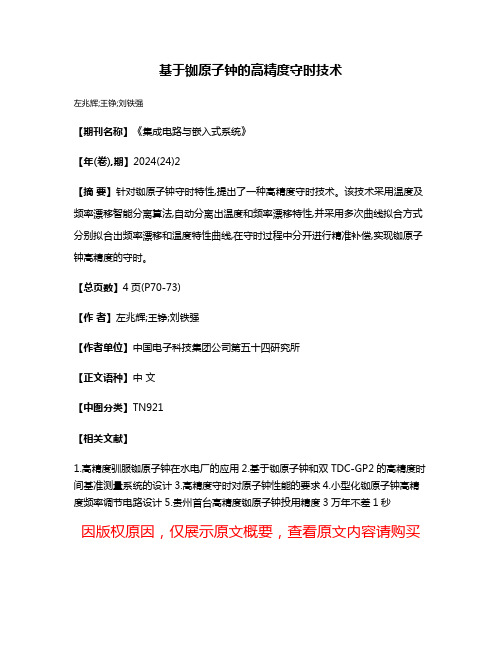
基于铷原子钟的高精度守时技术
左兆辉;王铮;刘铁强
【期刊名称】《集成电路与嵌入式系统》
【年(卷),期】2024(24)2
【摘要】针对铷原子钟守时特性,提出了一种高精度守时技术。
该技术采用温度及频率漂移智能分离算法,自动分离出温度和频率漂移特性,并采用多次曲线拟合方式分别拟合出频率漂移和温度特性曲线,在守时过程中分开进行精准补偿,实现铷原子钟高精度的守时。
【总页数】4页(P70-73)
【作者】左兆辉;王铮;刘铁强
【作者单位】中国电子科技集团公司第五十四研究所
【正文语种】中文
【中图分类】TN921
【相关文献】
1.高精度驯服铷原子钟在水电厂的应用
2.基于铷原子钟和双TDC-GP2的高精度时间基准测量系统的设计
3.高精度守时对原子钟性能的要求
4.小型化铷原子钟高精度频率调节电路设计
5.贵州首台高精度铷原子钟投用精度3万年不差1秒
因版权原因,仅展示原文概要,查看原文内容请购买。
铷原子钟知识
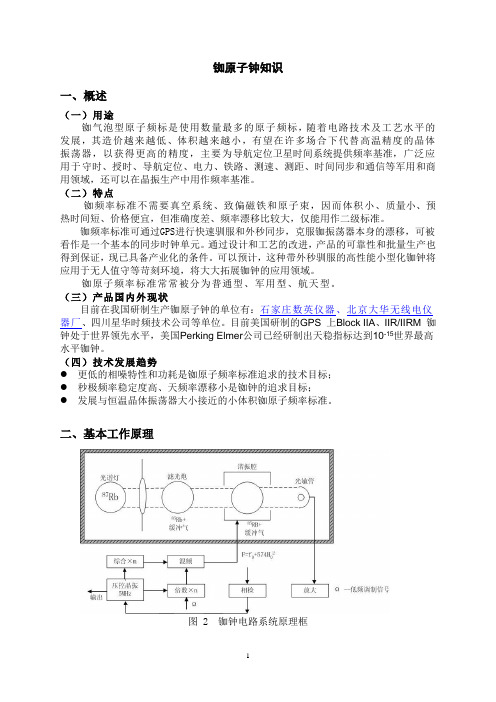
铷原子钟知识一、概述(一)用途铷气泡型原子频标是使用数量最多的原子频标,随着电路技术及工艺水平的发展,其造价越来越低、体积越来越小,有望在许多场合下代替高温精度的晶体振荡器,以获得更高的精度,主要为导航定位卫星时间系统提供频率基准,广泛应用于守时、授时、导航定位、电力、铁路、测速、测距、时间同步和通信等军用和商用领域,还可以在晶振生产中用作频率基准。
(二)特点铷频率标准不需要真空系统、致偏磁铁和原子束,因而体积小、质量小、预热时间短、价格便宜,但准确度差、频率漂移比较大,仅能用作二级标准。
铷频率标准可通过GPS进行快速驯服和外秒同步,克服铷振荡器本身的漂移,可被看作是一个基本的同步时钟单元。
通过设计和工艺的改进,产品的可靠性和批量生产也得到保证,现已具备产业化的条件。
可以预计,这种带外秒驯服的高性能小型化铷钟将应用于无人值守等苛刻环境,将大大拓展铷钟的应用领域。
铷原子频率标准常常被分为普通型、军用型、航天型。
(三)产品国内外现状目前在我国研制生产铷原子钟的单位有:石家庄数英仪器、北京大华无线电仪器厂、四川星华时频技术公司等单位。
目前美国研制的GPS 上Block IIA、IIR/IIRM 铷钟处于世界领先水平,美国Perking Elmer公司已经研制出天稳指标达到10-15世界最高水平铷钟。
(四)技术发展趋势●更低的相噪特性和功耗是铷原子频率标准追求的技术目标;●秒极频率稳定度高、天频率漂移小是铷钟的追求目标;●发展与恒温晶体振荡器大小接近的小体积铷原子频率标准。
二、基本工作原理图 2 铷钟电路系统原理框铷原子钟主要由单片机电路、伺服电路、微波倍频电路、频率调制、倍频综合电路几个模块组成,系统原理框如图2所示。
铷频标是一种被动型原子频率,利用的是基态超精细能级之间的跃迁,相应的跃迁频率为6834.682614MHz。
原子迁跃对微波信号起鉴频作用而产生误差信号,通过锁相环路伺服晶振的频率,使激励信号频率锁定到原子跃迁频率,实现晶振输出频率的高度稳定和准确。
HT5332D时间校准仪铷原子钟的研究与证明
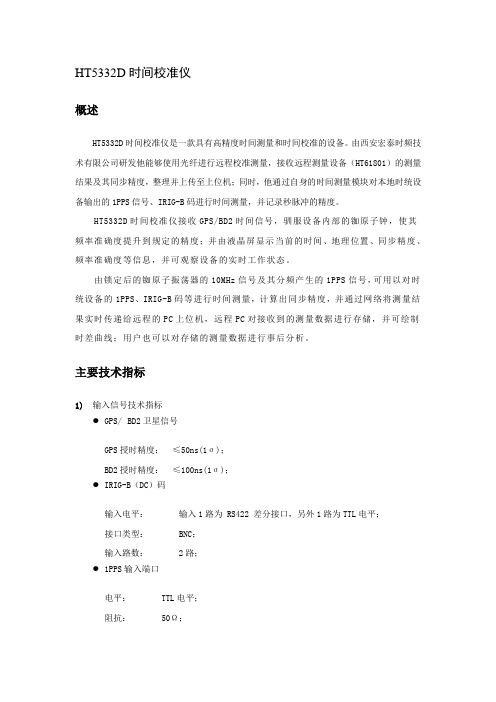
HT5332D时间校准仪概述HT5332D时间校准仪是一款具有高精度时间测量和时间校准的设备。
由西安宏泰时频技术有限公司研发他能够使用光纤进行远程校准测量,接收远程测量设备(HT61801)的测量结果及其同步精度,整理并上传至上位机;同时,他通过自身的时间测量模块对本地时统设备输出的1PPS信号、IRIG-B码进行时间测量,并记录秒脉冲的精度。
HT5332D时间校准仪接收GPS/BD2时间信号,驯服设备内部的铷原子钟,使其频率准确度提升到规定的精度;并由液晶屏显示当前的时间、地理位置、同步精度、频率准确度等信息,并可观察设备的实时工作状态。
由锁定后的铷原子振荡器的10MHz信号及其分频产生的1PPS信号,可用以对时统设备的1PPS、IRIG-B码等进行时间测量,计算出同步精度,并通过网络将测量结果实时传递给远程的PC上位机,远程PC对接收到的测量数据进行存储,并可绘制时差曲线;用户也可以对存储的测量数据进行事后分析。
主要技术指标1)输入信号技术指标●GPS/ BD2卫星信号GPS授时精度:≤50ns(1σ);BD2授时精度:≤100ns(1σ);●IRIG-B(DC)码输入电平:输入1路为 RS422 差分接口,另外1路为TTL电平;接口类型: BNC;输入路数: 2路;●1PPS输入端口电平: TTL电平;阻抗: 50Ω;路数: 2路。
2)输出信号技术指标●10MHz、5MHz信号输出频率稳定度:≤3.0E-12/s;频率准确度:≤5.0E-12;输出路数:各2路。
●1pps输出信号输出电平:其中1路为RS422电平,另外1路为TTL电平;脉冲宽度: 30ms;上升沿:<20ns;同步精度:≤50ns;物理接口: BNC;输出路数: 2路。
3)测量精度●时间间隔测量范围: 10ns至1s;●分辨力: 0.3ns;●B码调制秒同步测量误差:≤10ns(上升沿小于20ns);●1PPS同步测量误差:≤10ns。
一种微型化铷原子钟
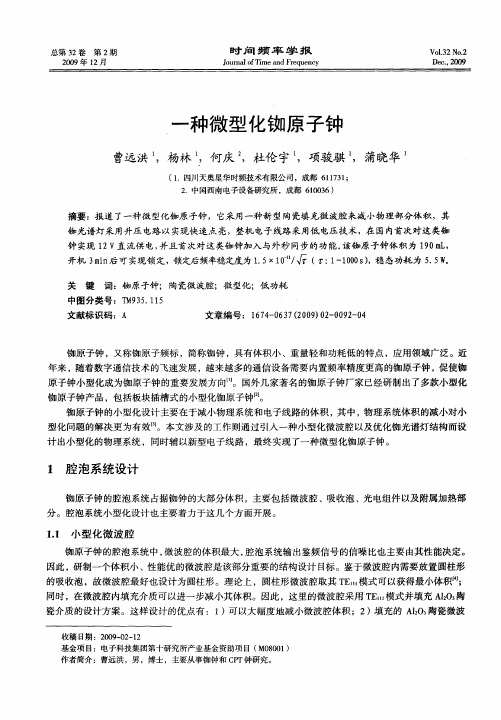
( : ~ 00 ) 稳 态功耗 为 5 5 。 1 10 , s . W
中图分 类号 :T 9 5 1 M 3 . 1 5
文献标 识码 :A
铷 原子 钟 ,又称 铷原 子频 标 ,简 称 铷钟 ,具有 体积 小 、重量 轻 和功耗 低 的特 点 ,应 用领 域 广泛 。近
2 铷 光 谱 灯 设 计
铷 光 谱 灯 的小 型化 设 计 主要 在 高频 振 荡 电路 和机 械 结构 2 方 面进行 。 个
21 高 频 振 荡 电路 .
高频振荡 电路的作用是激励铷灯泡发光 。 进行小型化设计时 , 要求铷光谱灯能被快速激发点亮 。因
总第 3 2卷
第 2 期
时 间 频 率 学 报
Ju a f i n rq e c o r l mea dF e u n y n oT
20 0 9年 l 月 2
V 1 2No2 o . . 3 De . 2 0 e, 0 9
一
种 微 型 化铷 原 子钟
曹远 洪 1 7杨林 ,何 庆 ,杜伦 宇 ,项骏骐 ,蒲晓华
瓷介质的设计方案 。这样设计的优点有 :1 )可以大幅度地减小微波腔体积 ;2 填充的 A , ) 1 陶瓷微波 O
收稿 日期 :2 0 — 2 1 09 0 — 2
基金项 目:电子科技集团第 十研究所产业基金资助项 目 ( 8 0 ) M0 0 1
作 者简介 :曹远洪 ,男 ,博士 ,主要从 事铷钟和 C T钟研究。 P
第2 期
曹远洪等 :一种微型化铷原子钟
损 耗 小 ,腔 Q值 高 ;3)A s 1 陶瓷 热 导性 好 ,便 于对 吸 收泡 快 速加 热 。 O
铷原子频率标准tr2005c技术指标
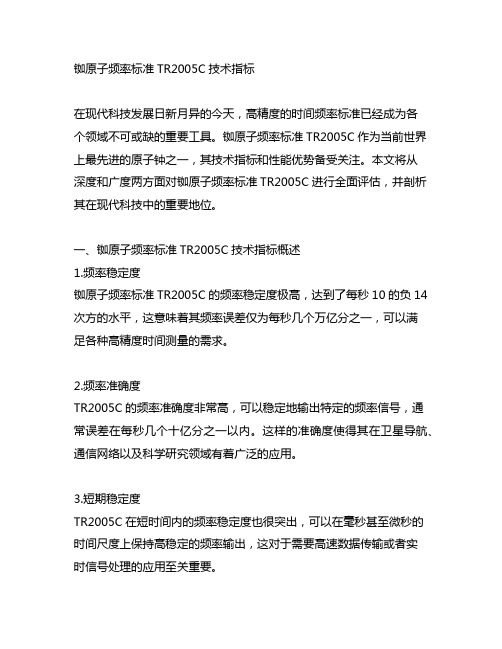
铷原子频率标准TR2005C技术指标在现代科技发展日新月异的今天,高精度的时间频率标准已经成为各个领域不可或缺的重要工具。
铷原子频率标准TR2005C作为当前世界上最先进的原子钟之一,其技术指标和性能优势备受关注。
本文将从深度和广度两方面对铷原子频率标准TR2005C进行全面评估,并剖析其在现代科技中的重要地位。
一、铷原子频率标准TR2005C技术指标概述1.频率稳定度铷原子频率标准TR2005C的频率稳定度极高,达到了每秒10的负14次方的水平,这意味着其频率误差仅为每秒几个万亿分之一,可以满足各种高精度时间测量的需求。
2.频率准确度TR2005C的频率准确度非常高,可以稳定地输出特定的频率信号,通常误差在每秒几个十亿分之一以内。
这样的准确度使得其在卫星导航、通信网络以及科学研究领域有着广泛的应用。
3.短期稳定度TR2005C在短时间内的频率稳定度也很突出,可以在毫秒甚至微秒的时间尺度上保持高稳定的频率输出,这对于需要高速数据传输或者实时信号处理的应用至关重要。
4.长期稳定度除了短期稳定度外,TR2005C在长时间尺度上也能够保持出色的频率稳定性,这对于天文观测、卫星定位和导航系统的精准定位以及地震监测等方面具有重要意义。
二、铷原子频率标准TR2005C的应用领域1.卫星导航高精度的时间频率标准是卫星导航系统的核心,而TR2005C凭借其卓越的频率稳定度和准确度,成为了众多卫星导航系统的首选时钟设备,为全球定位系统(GPS)、北斗导航系统等提供了可靠的时间基准。
2.通信网络在高速通信网络中,精准的时间同步对于数据传输和网络安全至关重要。
TR2005C作为高稳定频率标准的代表,被广泛应用于各种通信基站的时间同步系统,保障了通信网络的高效运行。
3.科学研究在科学实验和研究中,时间频率的精准度直接影响着实验数据的准确性和科学结论的可靠性。
TR2005C在科学研究领域有着广泛的应用,为实验数据的采集和分析提供了可靠的时间基准。
gps时间原理

gps时间原理
GPS时间是指全球定位系统(GPS)卫星中的原子钟所显示的时间。
GPS卫星通过发送信号到地面接收器上的定位设备,
来确定地球上的位置和时间。
在GPS系统中,时间是一项非
常关键的因素,因为它需要提供高精度的位置信息。
GPS时间的原理可以概括为以下几点:
1.原子钟:GPS卫星上搭载着高精度的原子钟,一般为铷原子钟。
原子钟的稳定性非常高,可以提供非常准确的时间信号。
2.时间戳:每当GPS卫星发送一个信号到地面接收器时,信
号中都包含一个时间戳。
时间戳是一个记录了卫星发送信号时刻的时间信息。
地面接收器接收到信号后会解析该时间戳,并将其与接收到信号的本地时间进行比较。
3.纠正差距:由于GPS卫星上的原子钟与地面接收器上的时
钟可能存在微小的误差,地面接收器需要对这些误差进行纠正。
地面接收器会使用GPS卫星网络中的其他卫星信号来计算出
综合时间误差,并校正接收器的本地时钟。
4.GPS时间标准:GPS系统中有一个参考时间标准,称为GPS 系统时(GPS Time),它是由卫星上的原子钟所提供的精确
时间。
然而,由于GPS设备上的时钟可能存在漂移或不准确
的情况,因此还会有一个本地时钟,称为卫星导航定时(Satellite Navigation Timing,简称SNT)。
通过以上机制,GPS系统可以提供高精度的时间信息,以及
准确的位置信息。
这对于很多应用来说都非常重要,比如导航、时钟同步、地震监测等。
原子钟的故事
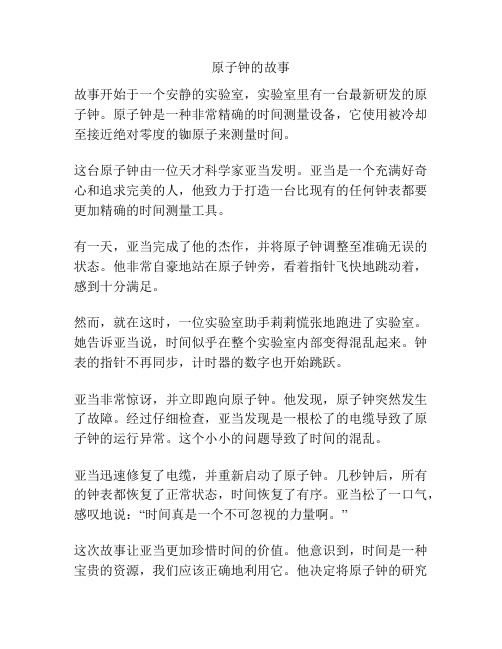
原子钟的故事故事开始于一个安静的实验室,实验室里有一台最新研发的原子钟。
原子钟是一种非常精确的时间测量设备,它使用被冷却至接近绝对零度的铷原子来测量时间。
这台原子钟由一位天才科学家亚当发明。
亚当是一个充满好奇心和追求完美的人,他致力于打造一台比现有的任何钟表都要更加精确的时间测量工具。
有一天,亚当完成了他的杰作,并将原子钟调整至准确无误的状态。
他非常自豪地站在原子钟旁,看着指针飞快地跳动着,感到十分满足。
然而,就在这时,一位实验室助手莉莉慌张地跑进了实验室。
她告诉亚当说,时间似乎在整个实验室内部变得混乱起来。
钟表的指针不再同步,计时器的数字也开始跳跃。
亚当非常惊讶,并立即跑向原子钟。
他发现,原子钟突然发生了故障。
经过仔细检查,亚当发现是一根松了的电缆导致了原子钟的运行异常。
这个小小的问题导致了时间的混乱。
亚当迅速修复了电缆,并重新启动了原子钟。
几秒钟后,所有的钟表都恢复了正常状态,时间恢复了有序。
亚当松了一口气,感叹地说:“时间真是一个不可忽视的力量啊。
”这次故事让亚当更加珍惜时间的价值。
他意识到,时间是一种宝贵的资源,我们应该正确地利用它。
他决定将原子钟的研究推向更深层次,希望能为人们提供更加准确的时间测量工具,帮助他们更好地管理和规划自己的时间。
从那天起,亚当致力于改进原子钟的技术,并将其应用于更广泛的领域。
他的工作获得了广泛的赞誉和认可,并为人们的生活和工作带来了巨大的便利。
这个故事告诉我们,时间是一种宝贵的资源,我们应该懂得珍惜和合理利用。
原子钟的故障提醒了亚当和莉莉,时间的流逝是不可逆转的,我们应该学会善于安排和管理自己的时间,创造更加有意义和有成就感的人生。
- 1、下载文档前请自行甄别文档内容的完整性,平台不提供额外的编辑、内容补充、找答案等附加服务。
- 2、"仅部分预览"的文档,不可在线预览部分如存在完整性等问题,可反馈申请退款(可完整预览的文档不适用该条件!)。
- 3、如文档侵犯您的权益,请联系客服反馈,我们会尽快为您处理(人工客服工作时间:9:00-18:30)。
铷原子钟
铷原子钟
概述
铷原子钟是中科院武汉物理与数学研究所研制的一款高精度、高可靠性同步时钟产品。
该时钟将高稳定性铷振荡器与GPS高精度授时、测频及时间同步技术有机的结合在一起,使铷振荡器输出频率驯服同步于GPS卫星铯原子钟信号上,提高了频率信号的长期稳定性和准确度,能够提供铯钟量级的高精度时间频率标准,是通信广电等部门替代铯钟的高性价比产品。
铷原子钟输出的1pps信号,是由铷振荡器频率信号分频得到的,并且同步于GPS输出的UTC时间,同时能够克服GPS接收机秒脉冲信号跳变带来的影响,是真正复现的“UTC时间基准”。
当GPS失锁或出现异常不可用时,系统能够智能判别,切换到铷钟进行守时,继续提供高可靠性的时间频率信号。
铷原子钟溯源同步到GPS卫星铯原子钟上,输出频率几乎没有漂移,所以不需送上级计量部门进行周期校准,性能接近铯钟,但却远远低于铯钟的价格,而且不存在铯钟那样铯束管寿命短需要高成本更换的问题。
铷原子钟非常适合应用于SDH数字同步网的1,2级节点时钟,为电力、电信、广电、时统、计量校准、雷达设备等提供高精度的时间和频率基准。
主要特点
l 内置铷振荡器(由中科院武汉物理与数学研究所中科时润频标技术公司自主研发)
l 日平均频率准确度<2×10P-12P
l 时间实时显示
l 驯服、保持自动切换
l GPS失锁后依靠铷钟高精度守时
l 低相噪频率信号输出
l 测频精度<2×10P-12P/天
l 具备TRAIM算法的GPS接收机
输出信息
l 10MHz
1路,BNC接口,50Ω正弦波,
输出幅度:12dBm±1dB
准确度:≤2E-12(开机48小时以后,GPS锁定状态,24小时平均准确度)
开机特性:加电5分钟:≤5E-10
加电4小时:≤1E-11
加电12小时后:≤5E-12
稳定度:<6 E -10/1ms
<1 E -10/10ms
<6 E -11/100ms
<1 E-11/1s
<5 E-12/10s
<3 E-12/100s
<1 E-12/日(GPS锁定)
相位噪声:≤ -90dBc/Hz @10Hz
≤-130dBc/Hz @100Hz
≤-140dBc/Hz @1kHz
≤-160dBc/Hz ≥10kHz
失真:谐波:≤-50dBc
非谐波:≤-100dBc
l 5MHz、1MHz各1路,指标同10MHz
l GPS秒脉冲
1路,BNC,TTL电平,输出阻抗50Ω
授时精度:<50ns
脉冲宽度:20ms
上升沿: <10ns
l 分频秒脉冲
1路,BNC,TTL电平,输出阻抗50Ω
同步精度:<100ns
脉冲宽度:500ms
上升沿: <10ns
抖动: <1ns
当GPS锁定时,秒脉冲与GPS同步
当GPS失锁时,由内置铷原子频标保持
l RS232接口
MOTOROLA二进制GPS信息 @@Ha
波特率:9600,数据位:8,奇偶校验:NULL,停止位:1。
